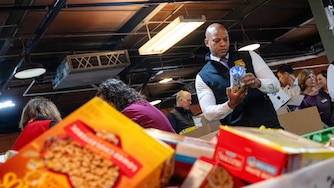Steve Parke’s brush with greatness began with the stroke of a ballpoint pen against a cocktail napkin. Those pivotal scribblings backstage at a Washington, D.C., club led to working closely with one of music’s most influential geniuses. Hint: His reign was purple. And very funky.
“He made things happen,” said Parke, a former Baltimore resident now living outside Frederick and the longtime in-house art director for one Prince Rogers Nelson, aka His Royal Badness, aka The Artist. In his 13 years in and around Paisley Park, Prince’s Minnesota headquarters, Parke created stage sets, T-shirts, album covers and designs that helped establish the legend’s visual style.
At the Catonsville branch of the Baltimore County Public Library on Thursday, he’ll tell stories of his time with the “Purple Rain” auteur and introduce “Prince: Icon,” a bound collection of images that runs the length of the guitarist, singer and style revolutionary’s career for which Parke served as consultant editor.

The son of a U.S. Army veteran, Parke spent a lot of his youth in Fairfax, Virginia, studying theater at George Mason University and designing posters, programs and sets. After moving to Baltimore as a young adult, he worked retail jobs while pursuing whatever creative projects he could, such as illustration work for magazines and photographing local acts.
One night he photographed Lionel Richie, whose opening act was fierce Prince protégé and percussionist Sheila E. While backstage, he met Sheila’s guitarist, Levi Seacer Jr., and drew a quick sketch on that napkin.
The two exchanged numbers, and Seacer soon called to see if Parke could send paintings to Minneapolis for his new boss, Prince, to see. (That must have been a really great napkin drawing.) “I got a call out of the blue from Prince’s manager at the time saying, ‘Would you come work on a video set?’” Parke said.

So Parke flew from Maryland to Minnesota to meet Prince. “I was trying to hold my fan self back. He told me, ‘I’m heading out, leaving for France in three hours.’” In the meantime, Prince asked, could Parke come up with a design for the video for “Glam Slam,” a song from the “Lovesexy” album? No pressure or anything! “This all sounds like a cliché, but I pulled a piece of illustration board out of the trash, took a colored pencil and started drawing on top. He gave me a thumbs-up, and he left.”
With that, Parke was hired and worked straight “for 72 hours, cranking any caffeine I could. I thought I was going to drop dead of a heart attack.”
He didn’t know if Prince liked the result because “I didn’t hear anything. They [Prince’s team] said, ‘Then you’re good. Keep going.’” Thus began a collaboration with a man whose particular and unusual nature is the stuff of legend.
“He was great sometimes and was not great at other times,” Parke said. “He was a boss and all the things that go along with it. Sometimes he’d go back and forth with you. He could be your boss, or a good friend, and then he could become the biggest persona that anyone who thinks of how Prince would be.”
Read More
Once he learned to gauge which Prince he was getting, their working relationship became, well, in sync. “He would call me in my office and say, ‘Hey, come down to the studio,’ and he’d wave me in while he was laying down a guitar track and say, ‘What do you think?’ He shared things with me, gave me insight into where he was musically. It was very, very cool.”
From 1988 to 2001, Parke spent one week a month in Minneapolis and the rest in Baltimore — though Prince wanted him to relocate. “At another time in my life, I would have said, ‘Hell, yes, I’m moving tomorrow’ without asking my wife, which would have been a bad idea,” he said. During his tenure, he did sets, created album covers, hand-painted guitars and even helped redesign Paisley Park to make it look less corporate. “He gave me opportunities I didn’t have anywhere else.”
But when Parke’s son was born it was time to come back to Baltimore full time. “I needed to forge a new path,” said Parke, whose more recent work includes “I, Paparazzi,” a graphic novel from DC Comics. Prince’s camp called him a few times for projects, but Parke said no. “A few days with him turn into weeks. I was trapped by reality.”

Reality came crashing on April 21, 2016, when a friend from St. Paul, Minnesota, called. “He just told me, ‘Somebody found a dead body at Paisley Park,’ and I said ‘I know who it’s not.’ That’s where my brain went,” said Parke, who hadn’t seen Prince in years. “But all of a sudden my phone started blowing up. I was just stunned by it. How do you react? I was like, ‘We’re gonna find out the reporting was wrong.’”
Sadly, the media was right. “In addition to being someone I’d spent a lot of time with, he [Prince] was a huge part of my life before I even met him — when I was a kid, at that time of your life when a musician or an actor can take on a life of their own in your head. And that part was gone, too.”
Parke contributed artwork to the memorials at Paisley Park but didn’t attend any. “I couldn’t deal with it,” he said. But Parke did return for a celebration in 2017 and was struck that, in more than a decade, the singer “had not made changes to the interiors from when we worked on it. He kept it.”





Comments
Welcome to The Banner's subscriber-only commenting community. Please review our community guidelines.